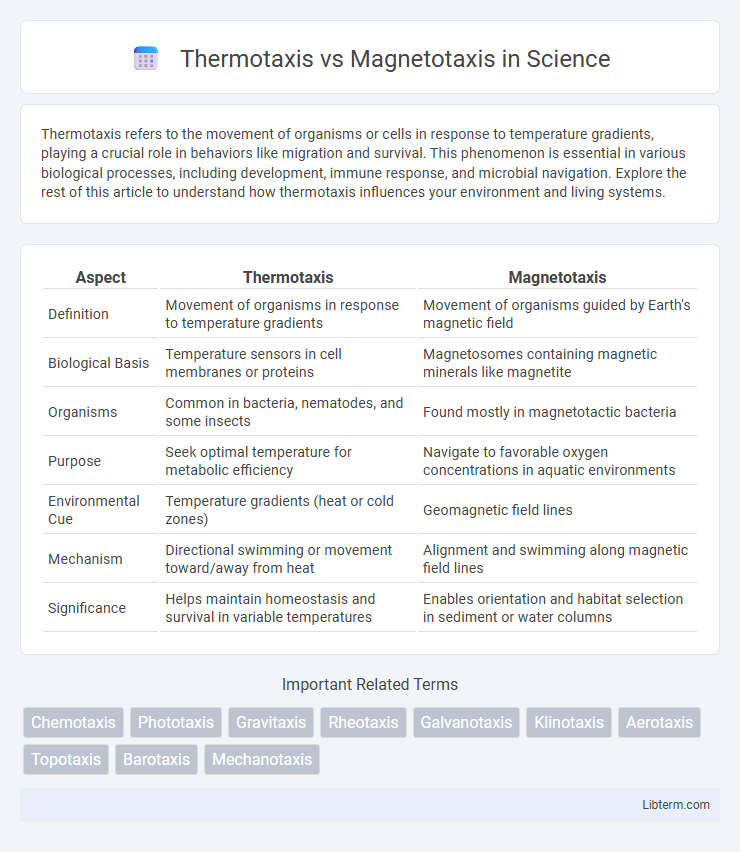Thermotaxis refers to the movement of organisms or cells in response to temperature gradients, playing a crucial role in behaviors like migration and survival. This phenomenon is essential in various biological processes, including development, immune response, and microbial navigation. Explore the rest of this article to understand how thermotaxis influences your environment and living systems.
Table of Comparison
| Aspect | Thermotaxis | Magnetotaxis |
|---|---|---|
| Definition | Movement of organisms in response to temperature gradients | Movement of organisms guided by Earth's magnetic field |
| Biological Basis | Temperature sensors in cell membranes or proteins | Magnetosomes containing magnetic minerals like magnetite |
| Organisms | Common in bacteria, nematodes, and some insects | Found mostly in magnetotactic bacteria |
| Purpose | Seek optimal temperature for metabolic efficiency | Navigate to favorable oxygen concentrations in aquatic environments |
| Environmental Cue | Temperature gradients (heat or cold zones) | Geomagnetic field lines |
| Mechanism | Directional swimming or movement toward/away from heat | Alignment and swimming along magnetic field lines |
| Significance | Helps maintain homeostasis and survival in variable temperatures | Enables orientation and habitat selection in sediment or water columns |
Introduction to Taxis Mechanisms
Taxis mechanisms involve directed movement of organisms in response to environmental stimuli, crucial for survival and adaptation. Thermotaxis refers to movement along temperature gradients, allowing organisms to seek optimal thermal conditions. Magnetotaxis enables microorganisms to orient and migrate along magnetic field lines, facilitating navigation in aquatic habitats.
Defining Thermotaxis and Magnetotaxis
Thermotaxis refers to the directed movement of organisms or cells toward or away from a temperature gradient, allowing them to find optimal thermal conditions for survival. Magnetotaxis is the ability of certain bacteria to orient and migrate along magnetic field lines using intracellular magnetosomes, facilitating navigation in aquatic environments. Both mechanisms enable microorganisms to adapt and respond to environmental cues critical for their growth and survival.
Biological Importance of Thermotaxis
Thermotaxis plays a crucial role in guiding microorganisms and cells toward optimal temperature zones, enhancing survival and metabolic efficiency by avoiding harmful thermal extremes. This biological mechanism allows species such as bacteria, nematodes, and sperm cells to locate favorable environments, improving reproductive success and cellular function. In contrast, magnetotaxis primarily aids navigation through geomagnetic fields, while thermotaxis directly influences temperature-dependent physiological processes vital for organismal homeostasis.
Biological Importance of Magnetotaxis
Magnetotaxis enables magnetotactic bacteria to align and navigate along Earth's magnetic field lines, optimizing their search for optimal oxygen concentrations in stratified aquatic environments. This behavior facilitates efficient vertical migration to microaerophilic zones essential for their metabolic processes and survival. Magnetotaxis contributes to biogeochemical cycling by promoting bacterial localization in specific sediment layers, influencing nutrient turnover and sediment chemistry.
Molecular Mechanisms Underlying Thermotaxis
Thermotaxis relies on molecular thermoreceptors such as TRP channels that detect temperature changes, triggering intracellular signaling pathways to guide cellular movement or behavioral responses. These thermosensors alter ion flux and membrane potential, modulating neuronal activity that directs movement toward optimal thermal environments. In contrast, magnetotaxis involves magnetosome-containing bacteria utilizing magnetite particles to sense geomagnetic fields through physical alignment rather than molecular signal transduction pathways.
Molecular Mechanisms Underlying Magnetotaxis
Magnetotaxis is driven by specialized magnetosomes, intracellular organelles composed of magnetic iron minerals such as magnetite (Fe3O4) or greigite (Fe3S4), which enable bacteria to orient along geomagnetic fields. The synthesis and alignment of these magnetosomes involve intricate genetic regulation, including genes like mam and mms clusters that control biomineralization and chain formation. In contrast to thermotaxis, which relies on temperature-sensitive receptors and signaling pathways, magnetotaxis uniquely depends on the biogenesis and spatial organization of magnetosome chains anchored to the cytoskeleton, facilitating directional movement in magnetic gradients.
Comparative Evolution of Thermotaxis vs Magnetotaxis
Thermotaxis and magnetotaxis represent distinct evolutionary adaptations allowing microorganisms to navigate their environments using temperature gradients and Earth's magnetic field, respectively. Thermotaxis evolved primarily in bacteria inhabiting fluctuating thermal zones, facilitating survival through temperature-optimized metabolic activity, while magnetotaxis emerged later in magnetotactic bacteria, enabling orientation along geomagnetic field lines for efficient movement toward optimal redox zones. Comparative evolutionary studies reveal that thermotaxis relies on conserved chemosensory pathways, whereas magnetotaxis integrates unique biomineralization processes to form magnetosomes, highlighting divergent molecular mechanisms shaped by environmental pressures.
Ecological Roles and Environmental Impact
Thermotaxis and magnetotaxis guide microorganisms toward optimal habitats by sensing temperature gradients and magnetic fields, respectively, influencing microbial distribution and ecosystem functioning. Thermotactic microbes regulate biochemical processes in thermal environments, enhancing nutrient cycling and energy flow in hot springs and soils. Magnetotactic bacteria contribute to biogeochemical cycling by navigating sediment layers, impacting iron cycling and sediment stability in aquatic ecosystems.
Applications in Biotechnology and Medicine
Thermotaxis guides cells or microorganisms to optimal temperatures, enabling precise control in tissue engineering and targeted drug delivery systems by enhancing cellular responses to thermal gradients. Magnetotaxis leverages magnetic fields to direct magnetotactic bacteria or nanoparticles, facilitating targeted drug delivery, magnetic resonance imaging (MRI) contrast enhancement, and hyperthermia treatment for cancer. Both thermotaxis and magnetotaxis offer innovative, non-invasive strategies for improving diagnostic accuracy and therapeutic efficacy in personalized medicine.
Future Perspectives in Taxis Research
Future perspectives in taxis research emphasize enhancing the understanding of thermotaxis and magnetotaxis mechanisms to develop advanced bioengineering applications, such as targeted drug delivery and environmental sensing. Innovations in synthetic biology are poised to create engineered microorganisms with improved directional responses to temperature gradients and magnetic fields, enabling precise navigation in complex environments. Integrating nanoscale sensor technologies with taxis-driven systems holds promise for real-time monitoring and adaptive control in biomedical and ecological contexts.
Thermotaxis Infographic

 libterm.com
libterm.com